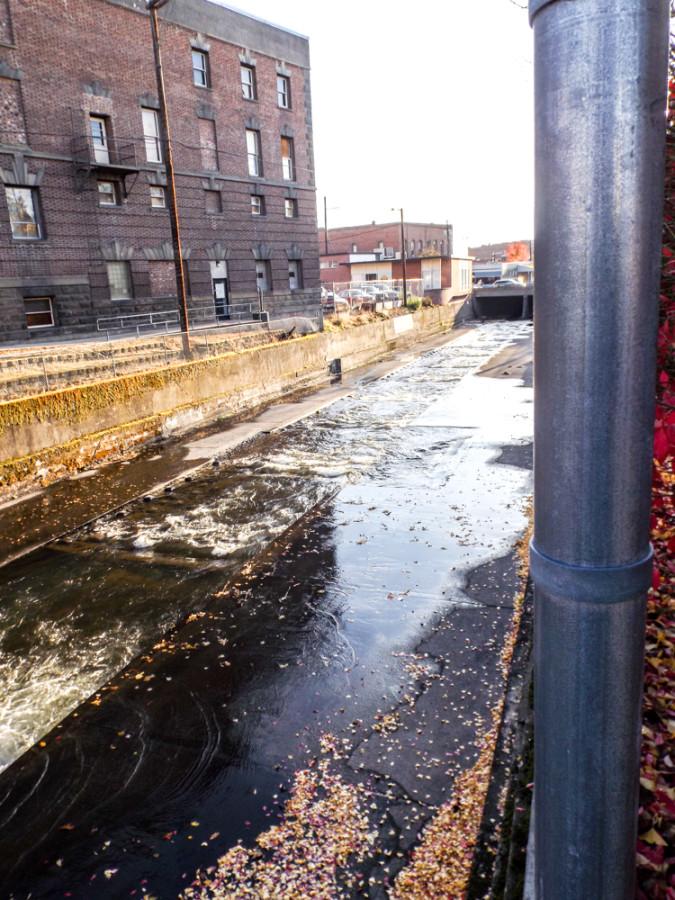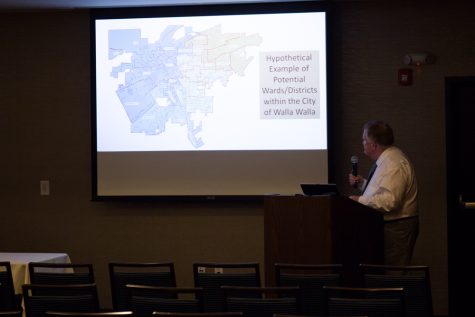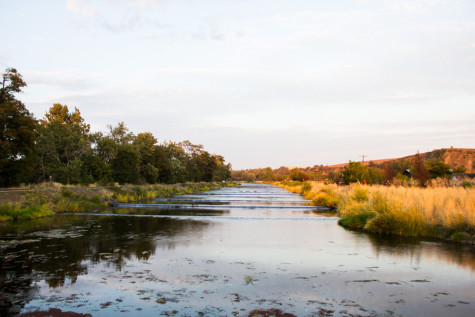Walla Walla considers daylighting Mill Creek
November 19, 2015
The Olmsted brothers, famous landscape architects of the twentieth century, created a plan for a vast and vibrant park system in Walla Walla that never got the chance to blossom. The torch is being picked up more than a hundred years later by Washington State University students who rediscovered the lost plans in the Whitman archives and hope to radically change the face of Walla Walla by “daylighting” Mill Creek.
Washington State University Architecture Professor Michael Sanchez became interested in rethinking Mill Creek after City Council Member Allen Pomraning and Fish and Wildlife Biologist Dana Sheedy approached him more than a year ago. Two separate classes have examined different portions of Mill Creek and formulated ideas for reinvigorating it, mainly by removing parking lots and streets that cover it in a process known as “daylighting.”
Architecture students exploring the Whitman archives over the past year discovered plans for Walla Walla designed by the Olmsted brothers in the early twentieth century. The brothers are famous for their role in creating New York City’s Central Park, the Seattle Park System and Stanford University’s campus plan.
“They had this whole master plan for how we could make this thread of parks through Walla Walla connected by they waterways and they identified Mill Creek as…the centerpiece of that plan and City Council decided only to adopt Pioneer Park from that plan,” said Whitman senior Andrew Reckers, who is an intern on the project.
Reckers got involved with the project through Judith Johnson, the program director of environmental nonprofit Kooskooskie Commons. Johnson is working with Sanchez and his students to educate the community in order to build support for the project.
“[T]here are proven methods of reconstructing flood control to be a more natural system and what we’re doing is just providing some of that information for people so they can see what the possibilities are. That’s the goal,” said Johnson.

A final plan is a long way off, but it would likely include measures to prevent flooding, such as terraced banks and a widened, vegetated levy. Before any binding decisions are made, the Army Corps of Engineer will have to consider every viable alternative and the community will have to work together to secure funding from the United States Congress, with contributions by the city and county governments.
Promraning has been a firm proponent of the project as a member of city council, and he believes it will improve Walla Walla by strengthening the town’s appeal to investors and tourists as well as improve the quality of life for residents.
“When I was a kid Walla Walla was a dying agricultural town, that was many years ago. Many of the storefronts were empty. Things were level but not good and since then a thousand people have worked to turn this town around…Everything has gotten so much better, and what is happening is we have turned into a resort community,” said Pomraning.
The success of daylighting in cities such as Kansas City, Mo., Denver, Colo. and Caldwell, Idaho has given Pomraning hope that daylighting Mill Creek, and making it an environmental, social and economic hub, can improve property values. Pomraning recognizes that this increase in rents and other costs could harm poorer residents of Walla Walla, if local government organizations and non-profits do not work to ensure continued services are provided.
“If you look at Bend or Sun Valley…after 30 years of being a resort community, many of your mid- and lower-income people are living 10 and 20 miles away. Do I want that to happen? No. Do I believe it can? Yes, if we don’t keep our policies and our sensitivities and our empathy at a really high level.”
According to Johnson 84 community members attended an informational meeting held at Walla Walla Community College on Nov. 2. Next month on Dec. 14, the WSU students will present to the Walla Walla City Council during a meeting held in Olin Hall from 4:00 to 6:00 p.m..
Those involved in the revision remain optimistic, although they recognize that this will take at least ten years to complete the project. One of the main strengths is the energy in the community and the students invested in this outcome.
“One of the reasons I felt it would be successful to have WSU students do this work was a student project is non-controversial,” said Johnson, “It isn’t a consulting firm from out of town it isn’t one entity paying for someone to come and do this. This is a service of our state universities…and it’s wonderful.”








Gene Spangrude • Nov 23, 2015 at 6:34 pm
Hopefully a ‘Local Entity’ can be granted and then take on complete responsibility for the Mill Creek Project; including Flood Management operations and the Operation and Maintenance responsibilities; as well as for dealing with any consequences after experiencing a flood event like 1996…..
This would make it easier for such experiments as this interesting proposal to go forward and become a reality……
It’s completion should give some interesting insights into the long term Flood Hydraulics of an Alluvial Fan situation; such as Mill Creek is through Walla Walla; and the close co-existence of a flood control channel and a developed area…..
Betty Simcock • Nov 20, 2015 at 3:46 pm
We have lived in WW for 34 years and have always pondered why the town basically hid Mill Creek. The potential is wonderful. I do hope we begin to explore just how to do this. Delighted to read this article.